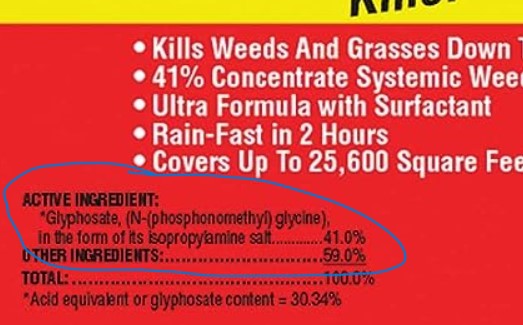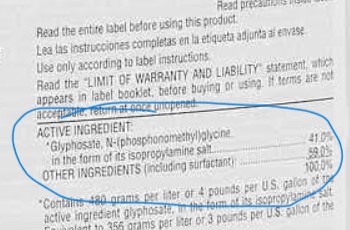Japanese Knotweed is a menace that is very difficult to control. It is native to areas where lava flows, yet some people seem to think they can kill it with tarps, incantations and smudge sticks. Below is, as condensed as possible, accurate information about how to control Japanese Knotweed: What to buy, where to buy it, how to dilute it, and how to apply it.
With apologies to folks in other places, this is a very USA specific post. There are just too many variations in what is available around the world to make a post that works for everyone.
WHAT TO BUY

There are NO READY TO USE PRODUCTS in the US that you want for Japanese Knotweed treatment. If it has a spray nozzle attached, then it has other herbicides mixed in. In the US, you need a concentrate and you will need to dilute it in a spray bottle you purchase.

You want to purchase a product that has the ONLY active ingredient listed as glyphosate. In the US, herbicide containers will have the list of active ingredients on the front. Find that list of active ingredients. See anything other than glyphosate in the list of active ingredients? If yes, you don’t want it.

Remember that you are buying “glyphosate,” not RoundUp. RoundUp is a brand name and they make a gajillion products, but only one of their products contains only glyphosate. Many companies make and sell glyphosate. Buy whichever you want, as long as the only active ingredient listed is glyphosate.
WHERE TO BUY
You’re going to need to buy a concentrate. (Again, Ready To Use versions aren’t available in the US right now.) Concentrate can be purchased many places with many different names. Some places that sell glyphosate concentrate include but are not limited to:
- Ace Hardware stores
- TrueValue hardware stores
- Home Depot
- Lowes
- Tractor Supply
- DoMyOwn.com
- DIYPestControl.com
- Amazon.com
- Agway
- GreenShootsOnline.com
Do not go looking for “RoundUp.” Instead, look for “glyphosate.”
HOW TO DILUTE CHEAT SHEET
The most popular concentrates are available in one of the concentrations listed below. For each concentration is listed how much product you want in a gallon of water.
- 53.8% concentration requires 4.75 ounces of concentrate per gallon of water
- 50% concentration requires 5.12 ounces of concentrate per gallon of water
- 48.7% concentration requires 5.25 ounces of concentrate per gallon of water
- 43% concentration requires 5.95 ounces of concentrate per gallon of water
- 41% concentration requires 6.24 ounces of concentrate per gallon of water
Remember that 1 ounce = 2 tablespoons, if you prefer to measure that way.
Add about 3/4 of the water to your tank, add your herbicide, then add enough water that you have 1 gallon of liquid in it.
If your concentrated herbicide doesn’t contain a surfactant, adding one teaspoon per gallon is recommended. Search for “non-ionic surfactant” and you will find it. Add this when you add the herbicide so the combined volume (herbicide + water + surfactant) is one gallon. If a surfactant isn’t an option for any reason then carry on without it.
HOW TO APPLY HERBICIDE
Herbicide can be sprayed, applied with a paint brush (or foam brush), with a “glove of death,” sponges glued to tongs (never done that myself but I think that is awesome) and other methods. I’m going to focus on spraying only for now.
Check your weather report. Make sure no rain is predicted for at least a few hours (glyphosate is rainfast in about 30 minutes) and when spraying you need to make sure there is little to no wind. You do not want to spray knotweed and have herbicide all over your other plants or yourself.
Site situations will vary but make sure you can reach the farthest points without walking through plants you’ve already sprayed. Sometimes this means walking to the farthest point and walking backward as you spray.
Remember that you want as much herbicide to reach the root as possible. So do your best to spray each and every leaf with herbicide. You don’t need to soak every leaf until it is dripping, but you do want herbicide on as many leaves as possible so that as much herbicide as possible reaches the root.
WHEN TO APPLY HERBICIDE
There are some emerging theories about whether to cut stalks in June and how early one can treat Japanese Knotweed but everybody agrees on this: Treatment must occur at least two weeks before the first frost.
Why? Because frost will kill the leaves (similar to pelargonic acid, diquat and some other herbicides) and that stops the circulatory process of the plant. If the glyphosate can’t circulate down to the roots then it is a wasted effort.
I’ve always cut stalks in June at about knee height and sprayed the stalks after the stalks have regrown and finished flowering. This has worked very well for me. This year due to a variety of circumstances I didn’t cut and I am treating the end of August, while the flower buds are still forming. This is an experiment for me that will allow me more time to treat the various stands I deal with, not need to deal with thousands of seeds dispersing, and an opportunity to continue other work treating invasives and growing other plants. It also will allow me more time to do fall planting in areas where I’ve treated knotweed.

Thank you.
As the mother of an autistic child I am asking you to stop the glyphosate applications. It is a devastating neurotoxin. It is a contributing g factor in the skyrocketing rates of autism
There is no proven link between glyphosate and autism. There isn’t any peer-reviewed study even suggesting a link, that I’m aware of. Importantly, I’m not suggesting spraying glyphosate willy-nilly all over the place. The instructions are clear and its use is safe when used as instructed: Wear proper clothing, spray diligently and carefully.
Concerns over glyphosate are reasonable and I share them when it comes to broad applications in scenarios including a high risk of exposure. Spraying fields of crops that have been genetically modified to be glyphosate resistant scares me. Tactical and creating targeted use of this chemical on infestations of invasive plants by trained individuals with proper PPE and notice is a lot less scary. Let’s keep things in perspective and not conflate the two.